Angkor Thom
The Great City or Capital
Angkor derives from Sanskrit word: “Nagara” meaning “City or Town or Capital”; “Thom” means “Great” so Angkor Thom meaning “Great City”. The town of Angkor Thom as we see it today, is not the first capital of ancient Cambodia in the same place. The first city was founded by king Yaçovarman I (899 to about 910). This king began his reign in the capital of his father Indravarman I at Hariharalaya. He abandoned the city in order to build his own capital Yaçodharapura meaning the “city of Yaçovarman”. It was recognized that the centre of this first city is the Phnom Bakheng. It was chosen for its proximity to the river Siem Reap which does not dry up and because the hill form a natural foundation for the pyramid of the God-King ritual. Yaçodharapura was larger than the present town (4 km at each side) owing to the security was good; it allowed the king to be surrounded the city by cheap enclosures of stake to protect the eastern side, he used the course of the river. The inscription says that the king Rajendravarman brought his capital back to Angkor because between 921 to 944 one king Jayavarman IV — the usurper founded the city at Koh Ker, about 100km northeast of Angkor. The king Rajendravarman did not re-installed the city on the same ground that had been marked out by Yaçovarman (the Bakheng). He erected the pyramid of Phimeanakas which resembles the temples of Koh Ker, as the center of the city. We know nothing of the walls of this town but the position of Phimeanakas which is almost the same distance from the South and East walls of Angkor Thom, from eastern dike of Western Baray and the Northern dike of the Basin behind Preah Khan, would make us suppose that its walls passed by these lines and were again include in part in the latter town. The Baphoun became the center of the third Angkor and was still on the same North-South axis. It was placed a little to the South. When Jayavarman VII (1181 to about 1220) came to power; he took over the reigns of the Khmer Empire at a difficult moment after the invasion of a Cham fleet which had destroyed the capital from end to end (1177-1181) and had taken away the greater part of the country’s properties. He displaced the center of the city and reduced the surface, thus making the perimeter les costly. In the middle he built the Bayon and made its walls of the town from laterites (8m high , 3km at each side and the moats: 100m wide). He made five gates which decorated the same each other; four gates located on the axis of the Bayon but one of them (Victory Gate) is on the axis of the Royal Enclosure. The Bayon and the gates get their special character from the great faces of Bodhisattva Avalokiteçvara; the old system of the images which existed already in the Hindu-monasteries of the 7th century and which enabled the whole world to be put under the benevolent protection of his quadruple face. The King decorated the bridge across the moats with the churning milky ocean motives.
Architectural Symbolism
This tradition was still so much alive at the time when Angkor Thom was restored by Jayavarman VII that compare the wall to the chain of mountains enclosing the universe and the surrounding moat to the ocean. “The first pierced the brilliant sky with its pinnacle the other reached down to the unplumbed depths of the world of serpents. This Mountain of Victory (Jaya Giri) and this ocean of victory (Jaya Sindhu) built by the king as his great glory. The bridge with Naga balustrades represent rainbow — the bridge between men and Gods. The bridges lead to the gates of the city which reproduced at four cardinal points in a reduced form. They represent the extension and projection of the Royal Power emanation from the temple in the four cardinal directions. The giant three-headed elephants on which are seated figures of Indra the wielder of thunderbolts and master of the thirty-third heaven. Thus, the rainbow is also the bow of Indra. This representation of the God Indra at the end of the bridge accentuates the fact that the bridge with the Naga balustrades is symbolic of the rainbow ladder.
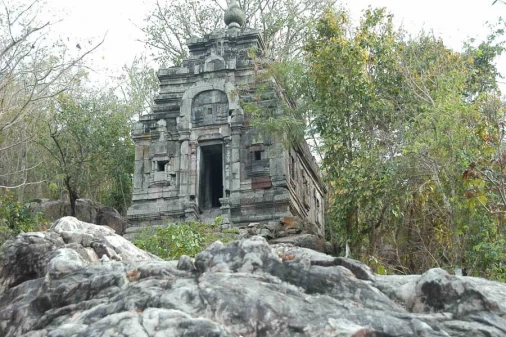
Angkor Borei
Angkor Borei is a town in the area of several ruins and archaeological digs. The area contains artifacts...
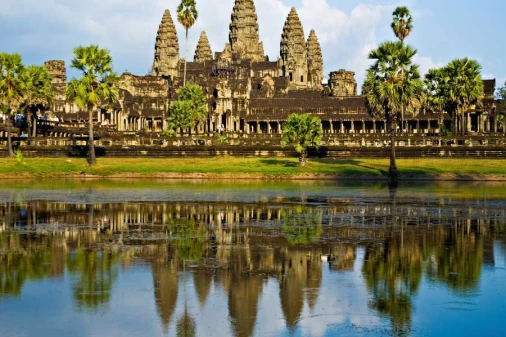
Angkor Wat
The traveller’s first glimpse of Angkor Wat, the ultimate expression of Khmer genius, is matched by...
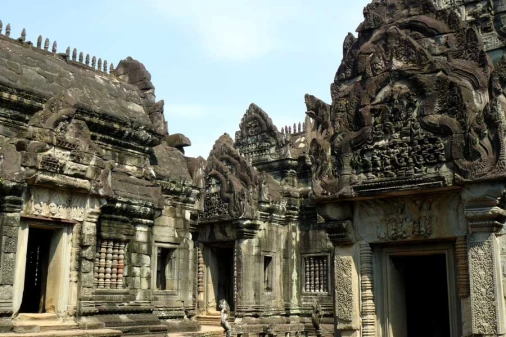
Banteay Sam Re
Banteay Sam Re located at Preah Dak commune, Bon Tiey Srey District by Charles De Gaulle Road via Angkor...
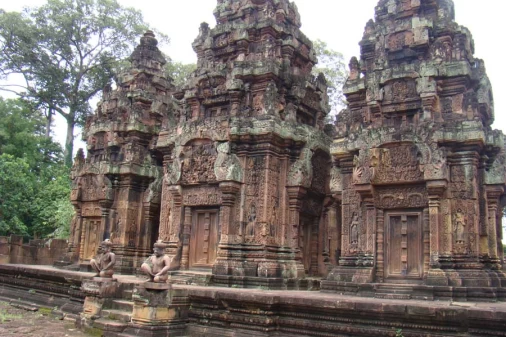
Banteay Srei Temple
Considered by many to be the jewel in the crown of Angkorian art, Banteay Srei is cut from stone of...
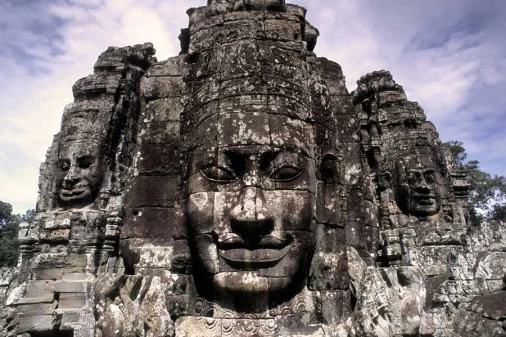
Bayon Temple
At the heart of Angkor Thom is the 12th-century Bayon, the mesmerising, if slightly mind-bending, state...
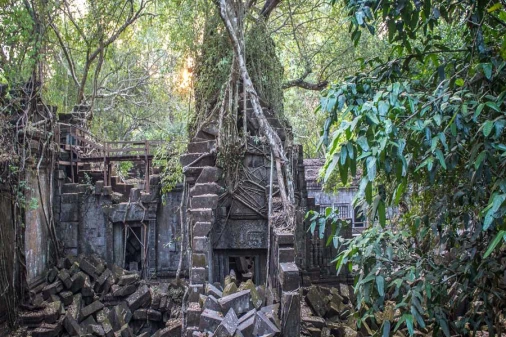
Beng Mealea Temple
A spectacular sight to behold, Beng Mealea, located about 68km northeast of Siem Reap, is one of the...
You may also like
Cambodia Discovery 7 Days
- Depart Time:Daily
- Starts/Ends:Phnom Penh/Siem Reap
- Tour type:Private Tours
- Travel Style:Heritage Tours, Family Tours, Culture & History
- Activities:Walking tours, Local culture tours, Cultural, religious and historic sites tours, Countryside and village visits tours
- Suitable for:Solo, Family, Group, Couple
- Age range:1 To 90 Years
- Operated in:English, French, Spanish, German, Italian
Cambodia Cities & Southern Coast 12 Days
- Depart Time:Daily
- Starts/Ends:Siem Reap /Phnom Penh
- Tour type:Private Tours
- Travel Style:Heritage Tours, Family Tours, Culture & History
- Activities:Walking tours, Local culture tours, Cultural, religious and historic sites tours, Countryside and village visits tours
- Suitable for:Solo, Family, Group, Couple
- Age range:1 To 90 Years
- Operated in:English, French, Spanish, German, Italian
Truly Cambodia 11 Days
- Depart Time:Daily
- Starts/Ends:Phnom Penh/Phnom Penh
- Tour type:Private Tours
- Travel Style:Heritage Tours, Family Tours, Culture & History
- Activities:Walking tours, Local culture tours, Cultural, religious and historic sites tours, Countryside and village visits tours
- Suitable for:Solo, Family, Group, Couple
- Age range:1 To 90 Years
- Operated in:English, French, Spanish, German, Italian
Cambdodia In Style 10 Days
- Depart Time:Daily
- Starts/Ends:Siem Reap /Phnom Penh
- Tour type:Private Tours
- Travel Style:Family Tours, Culture & History
- Activities:Walking tours, Local culture tours, Cultural, religious and historic sites tours, Countryside and village visits tours
- Suitable for:Solo, Family, Group, Couple
- Age range:1 To 90 Years
- Operated in:English, French, Spanish, German, Italian
 France
France  Spain
Spain  German
German  Italian
Italian 





 Vietnam Tours
Vietnam Tours  Cambodia Tours
Cambodia Tours  Myanmar tours
Myanmar tours  Thailand Tours
Thailand Tours  Laos Tours
Laos Tours